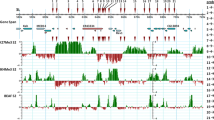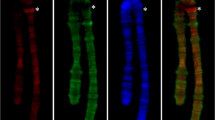Abstract
The formation of alpha and beta heterochromatin in chromosomes ofDrosophila melanogaster was studied in salivary glands (SGs) and pseudonurse cells (PNCs). In SGs ofX0, XY, XYY, XX andXXY individuals the amounts of alpha heterochromatin were similar, suggesting that theY chromosome does not substantially contribute to alpha heterochromatin formation. Pericentric heterochromatin developed a linear sequence of blocks in PNCs, showing morphology of both alpha and beta heterochromatin. In situ hybridization withRsp sequences (H o clone) revealed that the most proximal heterochromatic segment of the mitotic map (region h39) formed a polytenized block in PNCs. Dot analysis showed that the clone had a hybridization rate with PNC-DNA very close to that with DNA from mainly diploid head cells, whereas the homologous SG-DNA was dramatically underrepresented. A similar increase of DNA representation in PNC was found for AAGAC satellite DNA. The mitotic region h44 was found not to polytenize in the SG chromosome, whereas in PNC chromosome 2 this region was partly polytenized and presented as an array of several blocks of alpha and beta heterochromatin. The mapping of deficiencies with proximal breakpoints in the most distal heterochromatin segments h35 in arm 2L and h46 in 2R showed that the mitotic eu-heterochromatin transitions were located in SG chromosomes distally to the polytene 40E and 41C regions, respectively. Thus, the transition zones between mitotic hetero- and euchromatin are located in banded polytene euchromatin. A scheme for dynamic organization of pericentric heterochromatin in nuclei with polytene chromosomes is proposed.
Similar content being viewed by others
References
Bonaccorsi S, Lohe A (1991) Fine mapping of satellite DNA sequences along theY chromosome ofDrosophila melanogaster: relationship between satellite sequences and fertility factors. Genetics 129:177–189
Bridges CB (1937) Correspondences between linkage maps and salivary chromosome structure, as illustrated in the tip of chromosome 2R ofDrosophila melanogaster. Cytologia Fujii Jub: 745–755
Devlin RH, Bingham B, Wakimoto BT (1990a) The organization and expression of thelight gene, a heterochromatic gene ofDrosophila melanogaster. Genetics 125:129–140
Devlin RH, Holm DG, Morin KR, Honda BM (1990b) Identifying a single-copy DNA sequence associated with the expression of a heterochromatic gene, thelight locus ofDrosophila melanogaster. Genome 33:405–415
Dimitri P (1991) Cytogenetic analysis of the second chromosome heterochromatin ofDrosophila melanogaster. Genetics 127: 553–564
Gage LP (1974) Polyploidization of the silk gland ofBombyx mori. J Mol Biol 86:97–108
Gall JG (1973) Repetitive DNA inDrosophila. In: Hamkalo B, Papaconstantinou J (eds) Molecular cytogenetics. Plenum Press, New York, pp 59–74
Gall JG, Cohen EH, Polan ML (1971) Repetitive DNA sequences inDrosophild. Chromosoma 33:319–344
Gatti M, Pimpinelli S (1983) Cytological and genetic analysis of theY chromosome ofDrosophila melanogaster. I. Organization of the fertility factors. Chromosoma 88:349–373
Gatti M, Pimpinelli S (1992) Functional elements inDrosophila melanogaster heterochromatin. Ann Rev Genet 26:239–275
Glaser RL, Karpen GH, Spradling AC (1992) Replication forks are not found in aDrosophila minichromosome demonstrating a gradient of polytenization. Chromosoma 102:15–19
Heitz E (1934) Uber α- und β-Heterochromatin sowie Konstanz und Bau der Chromomeren beiDrosophila. Biol Zentralbl 54:588–609
Hilliker AJ (1976) Genetic analysis of the centromeric heterochromatin of chromosome 2 ofDrosophila melanogaster: deficiency mapping of EMS-induced lethal complementation groups. Genetics 83:765–782
Hilliker AJ, Appels R, Schalet A (1980) The genetic analysis ofD. melanogaster heterochromatin. Cell 21:607–619
Kafatos FC, Jones CW, Efstratiatis A (1979) Determination of nuclei acid sequence homologies and relative concentration by a dot hybridization procedure. Nucl Acids Res 7:1541–1552
Karpen GH, Spradling AC (1992) Analysis of subtelomeric heterochromatin in theDrosophila minichromosomeDp1187 by single P element insertional mutagenesis. Genetics 132:737–753
King RC (1970) Ovarian development inDrosophila melanogaster. Academic Press, New York San Francisco
King RC, Riley SF, Cassidy JD, White PE, Paik YK (1981) Giant polytene chromosomes from the ovaries of aDrosophila mutant. Science 212:441–443
Lakhotia SC, Jacob J (1974) EM autoradiographic studies on polytene nuclei ofDrosophila melanogaster. II. Organization and transcriptive activity of the chromocentre. Exp Cell Res 86:253–263
Le M-H, Duricka D, Karpen GH (1995) Islands of complex DNA are widespread in Drosophila centric heterochromatin. Genetics 141:283–303
Lindsley DL, Zimm GG (1992) The genome ofDrosophila melonogaster. Academic Press, San Diego New York Boston
Lohe AR, Brutlag DL (1986) Multiplicity of satellite DNA sequences inDrosophila melanogaster. Proc Natl Acad Sci USA 83:696–700
Lohe AR, Hilliker AJ, Roberts PA (1993) Mapping simple repeated DNA sequences in heterochromatin ofDrosophila melanogaster. Genetics 134:1149–1174
Mal'ceva NI, Zhimulev IF (1993) Extent of polyteny in the pericentric heterochromatin of polytene chromosomes of pseudonurse cells ofotu (ovarian tumor) mutants ofDrosophila melanogaster. Mol Gen Genet 240:273–276
Marchant GE, Holm DG (1988) Genetic analysis of the heterochromatin of chromosome 3 inDrosophila melanogaster. II. Vital loci identified through EMS mutagenesis. Genetics 120:519–532
Miklos GLG, Yamamoto MT, Davies J, Pirrotta V (1988) Microcloning reveals a high frequency of repetitive sequences characteristic of chromosome 4 and the β-heterochromatin ofDrosophila melanogaster. Proc Natl Acad Sci USA 85:2051–2055
Morgan TH, Bridges CB, Schultz J (1938) Investigation on the constitution of the germinal material in relation to heredity. Carnegie Inst Wash Yearb 37:304–309
Mulder MP, Duijn P van, Gloor HJ (1968) The replicative organization of DNA in polytene chromosomes ofDrosophila hydei. Genetica 39:385–428
Pavan C (1946) Two types of heterochromatin inDrosophila nebulosa. Proc Natl Acad Sci USA 32:137–145
Pimpinelli S, Dimitri P (1989) Cytogenetic analysis of segregation distortion inDrosophila melanogaster. The cytological organization of theResponder (Rsp) locus. Genetics 121:765–772
Pimpinelli S, Berloco M, Fanti L, Dimitri P, Bonaccorsi S, Marchetti E, Caizzi R, Caggese C, Gatti M (1995) Transposable elements are stable structural components ofDrosophila melanogaster heterochromatin. Proc Natl Acad Sci USA 92:3804–3808
Sambrook J, Fritsch EF, Maniatis T (1989) Molecular cloning: a laboratory manual. Cold Spring Harbor Laboratory, New York
Shevelyov YY (1992) Copies of aStellate gene variant are located in theX heterochromatin ofDrosophila melanogaster and are probably expressed. Genetics 132:1033–1037
Shevelyov YY (1993) Aurora, a non-mobile retrotransposon inDrosophila melanogaster heterochromatin. Mol Gen Genet 239:205–208
Shevelyov YY, Balakireva MD, Gvozdev VA (1989) Heterochromatic regions in differentDrosophila melanogaster stocks contain similar arrangements of moderate repeats with insertedcopia-like elements (MDG1). Chromosoma 98:117–122
Traverse KL, Pardue ML (1989) Studies of He-T DNA sequences in the pericentric regions ofDrosophila chromosomes. Chromosoma 97:261–271
Wu CI, Lyttle TW, Wu ML, Lin GF (1988) Association between a satellite DNA sequence and theresponder ofsegregation distorter inD. melanogaster. Cell 54:179–189
Yamamoto M, Mitchelson A, Tudor M, O'Hare K, Davies JA, Miklos GLG (1990) Molecular and cytogenetic analysis of the heterochromatin-euchromatin junction region of theDrosophila melanogaster X chromosome using cloned DNA sequences. Genetics 125:821–832
Zhang P, Spradling AC (1995) TheDrosophila salivary gland chromocenter contains highly polytenized subdomains of mitotic heterochromatin. Genetics 139:659–670
Zhimulev IF, Semeshin VF, Kulichkov VA, Belyaeva ES (1982) Intercalary heterochromatin inDrosophila. I. Localization and general characteristics. Chromosoma 87:197–228
Author information
Authors and Affiliations
Corresponding author
Additional information
Edited by: E.R. Schmidt
Rights and permissions
About this article
Cite this article
Koryakov, D.E., Belyaeva, E.S., Alekseyenko, A.A. et al. Alpha and beta heterochromatin in polytene chromosome 2 ofDrosophila melanogaster . Chromosoma 105, 310–319 (1996). https://doi.org/10.1007/BF02524649
Received:
Revised:
Accepted:
Issue Date:
DOI: https://doi.org/10.1007/BF02524649




